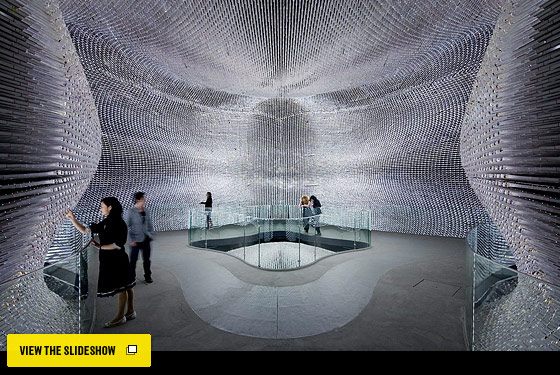

British architect Thomas Heatherwick, who is best known for buildings and bridges but also designs smaller-scale installations and furniture, has never showed his work in the United States. That will change on January 19, when he debuts “Extruding & Spinning” at Haunch of Venison New York (550 W. 21st St., nr. Eleventh Ave.; www.haunchofvenison.com; through March 3). To produce the pieces in the show, Heatherwick invested in the world’s largest extrusion machine, which squeezes out heated aluminum in free-form shapes. But his dreams don’t stop at the benches and furnishings that will be on display: Heatherwick is also developing building façades and architecture wielding this industrial machine. Photo: Peter Mallet

Heatherwick’s firm has produced innovative dynamic designs including buildings, bridges, and product since opening in 1994. This is his New Bus for London. It will debut this spring and be 15 percent more fuel efficient than the existing hybrid buses and 40 percent more efficient than the diesel-powered double-decker buses. Photo: Iwan Baan

Heatherwick Studio designed this extraordinary building that looks like a stylized dandelion flower for the U.K. Pavilion at the 2010 Shanghai Expo. The Seed Cathedral constructed for the Royal Botanic Gardens at Kew was made of 60,000 Perspex rods, each one encasing a different seed in the tip of its rod. It won the Expo’s Gold Medal. Photo: Iwan Baan

The interior of the Seed Cathedral, where you could see the different seeds in each rod up close, all the while feeling you were in a futurist spaceship. Photo: Iwan Baan

These playful Spun chairs, which Heatherwick designed in 2010, will be exhibited in the New York show. Originally the chairs were made of metal, developed with a metal workshop that specializes in making orchestra timpani drums. The Italian manufacturer, Magis, also produced the design in molded polyethylene for a more affordable price. Photo: Susan Smart

The Teesside Power Station was commissioned as a biomass-fueled power station on the banks of the river Tees in northern England. This rendering shows how the landscape will not only be part of the site but also part of the power plant, as indigenous flora will grow up on the exterior of the building. Photo: Courtesy of Heatherwick Studio

